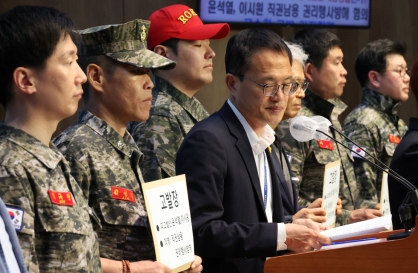[Editorial] Quick fix won't work
Heavy rain damage recurs annually; response systems must be revamped
By Korea HeraldPublished : July 18, 2023 - 05:30
The damage from the weekend's torrential rain is enormous across the country. A dayslong downpour brought mountain slopes crashing down on houses. Swollen rivers burst their banks, inundating villages and farmland. A multipurpose dam overflowed. Regular train services were interrupted.
There has been huge property damage, but above all, many people lost their lives. According to the Central Disaster and Safety Countermeasures Headquarters of the Ministry of the Interior and Safety, 41 people have died and nine are missing in flooding and landslides across the country. Fourteen people were found dead in a flooded tunnel in Osong-eup, Cheongju, North Chuncheong Province.
The meteorological authorities forecast heavy rain until Tuesday in the Chungcheong provinces, North Jeolla Province and northern parts of North Gyeongsang Province. Landslide alerts and watches are in effect in 87 sites including in Sejong, Cheonan in South Chungcheong Province, and Yongin in Gyeonggi Province. The nation must be fully prepared to minimize additional damage.
The Korea Meteorological Administration had expected El Nino to bring more rain than usual to the country this summer, particularly in July -- a prediction that proved true. It is pitiful to see scores of people lose their lives despite knowledge in advance that torrential rain was coming.
Natural disasters are beyond our control. However, it is possible to minimize the damage by taking proactive measures or responding swiftly. Debates are being raised yet again about whether property damage and loss of life were to a large extent “human-made.”
The authorities are under fire for their improper response, which some say resulted in greater casualties in the Osong submerged underpass. It was an accident in which flash floods trapped 17 vehicles in a tunnel on Saturday after rain washed away the embankment of the nearby Miho River, a tributary of the Geum River.
The Geum River Flood Control Office reportedly claimed that it let the local government with jurisdiction over the tunnel know hours before the accident occurred that traffic control was necessary. However, traffic was not controlled at the proper time.
A provincial official reportedly said that there was no time to stop vehicles from entering the tunnel because a lot of water rushed in shortly after the Miho River embankment overflowed. This seems a lame excuse. A thorough investigation is needed.
This has become a recurring pattern every year with heavy rains. Dozens of people, including a family of three living in a Seoul semi-basement flat, died or went missing in localized torrential rain last year.
Despite recurring tragedies and foreseeable heavy rain, a proper response was not made. The root cause of the problem must be found. The government will have to review whether it has been taking adequate preventative measures, as well as whether its response manual is outdated. The National Assembly will also have to consider if it has been sitting on its hands about related laws and systems.
Natural disasters are becoming more dangerous and extreme due to climate change. Therefore, it is hard to deny that limitations on human-made measures are inevitable. But if the government had followed the basic rules and proper response procedures faithfully, the damage would have been greatly reduced.
The Interior Ministry and local governments must revamp danger prediction and response systems based on a thorough self-examination. Quick fixes cannot prevent the recurrence of a summer tragedy.
It is the government’s No. 1 duty to protect people’s safety and lives. The central and local governments must try their best to minimize additional damage of torrential rain through exhaustive preparations and rapid responses. In turn, people must not ease up on the authorities. They should watch weather conditions and follow instructions. The whole nation must keep in mind that extreme downpours, which occurred once every few decades, now repeats itself almost annually due to climate change.
-
Articles by Korea Herald






![[Weekender] How DDP emerged as an icon of Seoul](http://res.heraldm.com/phpwas/restmb_idxmake.php?idx=644&simg=/content/image/2024/04/25/20240425050915_0.jpg&u=)


![[Music in drama] An ode to childhood trauma](http://res.heraldm.com/phpwas/restmb_idxmake.php?idx=644&simg=/content/image/2024/04/25/20240425050929_0.jpg&u=)









![[Herald Interview] Mistakes turn into blessings in street performance, director says](http://res.heraldm.com/phpwas/restmb_idxmake.php?idx=652&simg=/content/image/2024/04/28/20240428050150_0.jpg&u=20240428174656)
